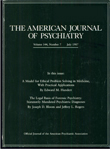Prospective Study of Posttraumatic Stress Disorder and Depression Following Trauma
Abstract
OBJECTIVE: The purpose of this study was to prospectively evaluate the onset, overlap, and course of posttraumatic stress disorder (PTSD) and major depression following traumatic events. METHOD: The occurrence of PTSD and major depression and the intensity of related symptoms were assessed in 211 trauma survivors recruited from a general hospital's emergency room. Psychometrics and structured clinical interview (the Structured Clinical Interview for DSM-III-R and the Clinician-Administered PTSD Scale) were administered 1 week, 1 month, and 4 months after the traumatic event. Heart rate was assessed upon arrival at the emergency room for subjects with minor physical injury. Twenty-three subjects with PTSD and 35 matched comparison subjects were followed for 1 year. RESULTS: Major depression and PTSD occurred early on after trauma; patients with these diagnoses had similar recovery rates: 63 survivors (29.9%) met criteria for PTSD at 1 month, and 37 (17.5%) had PTSD at 4 months. Forty subjects (19.0%) met criteria for major depression at 1 month, and 30 (14.2%) had major depression at 4 months. Comorbid depression occurred in 44.5% of PTSD patients at 1 month and in 43.2% at 4 months. Comorbidity was associated with greater symptom severity and lower levels of functioning. Survivors with PTSD had higher heart rate levels at the emergency room and reported more intrusive symptoms, exaggerated startle, and peritraumatic dissociation than those with major depression. Prior depression was associated with a higher prevalence of major depression and with more reported symptoms. CONCLUSIONS: Major depression and PTSD are independent sequelae of traumatic events, have similar prognoses, and interact to increase distress and dysfunction. Both should be targeted by early treatment interventions and by neurobiological research.



